Vianden
Vianden (Luxembourgish: Veianen) is a commune with city status in north-eastern Luxembourg, capital of the canton Vianden.
Vianden
Veianen | |
|---|---|
 Vianden and the Castle of Vianden. | |
 Coat of arms | |
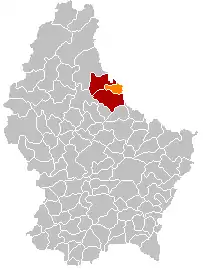 Map showing, in orange, the Vianden commune | |
| Coordinates: 49°56′01″N 6°12′27″E | |
| Country | |
| Canton | Viandenz |
| Commune | Vianden |
| Government | |
| • Mayor | Henri Majerus |
| Area | |
| • Total | 9.7 km2 (3.7 sq mi) |
| Highest elevation | 515 m (1,690 ft) |
| Lowest elevation | 198 m (650 ft) |
| Population (2017)[2] | |
| • Total | 2,008 |
| • Density | 210/km2 (540/sq mi) |
| Time zone | UTC+1 (CET) |
| • Summer (DST) | UTC+2 (CEST) |
| LAU2 | LU00004003 |
| Website | Official website |
History
The name of the town of Vianden is derived from the Gallic word vien which means "rocky". Already in the year 1256, Vianden is cited as a city, but it is only since 1308 that legally holds the title of city.[3]
Geography
The commune is in the Oesling, a region within the greater Ardennes area. Vianden is in the valley of the river Our, a tributary of the Sauer river, near the border between Luxembourg and Germany.
It has an area of 9.7 km2 (3.7 sq mi).[1] The altitude is 198–515 m (650–1,690 ft) high. At the church, the altitude is 224 m (735 ft) high.[4]
Vianden is surrounded by two communes of Luxembourg: Tandel to the south and west; and Putscheid to the northwest. To the north, west and southwest, Vianden borders with four municipalities of the Eifelkreis Bitburg-Prüm district of the German state of Rhineland-Palatinateː Waldhof-Falkenstein and Bauler to the north, Körperich to the east and Roth an der Our to the southeast.
Population
There were 2,008 persons living in the commune in 2017,[2] for a population density of 207.0 inhabitants/km².
Evolution of the population in Vianden
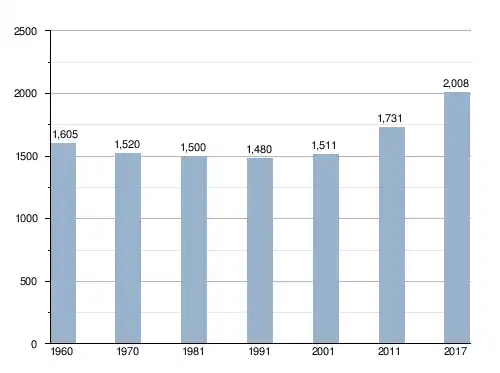
Places of interest
Some historic buildings in the commune areː[3]
- The Vianden Castle (French: Château de Vianden, German: Burg Vianden, Luxembourgish: Buerg Veianen) is one of the largest fortified castles west of the Rhine river. With origins dating from the 10th century, the castle was built in the Romanesque style from the 11th to 14th centuries.
- The Church of the Trinitarians, built in 1248 with its Gothic cloister.
- The City Hall, built in 1679.
- The St. Nicolas Church, built in the thirteenth century.
People from or related to Vianden
- Yolanda of Vianden, (1231–83), youngest daughter of Count Henry I, who joined the Convent of Marienthal.
- Victor Hugo (1802–85), the famous French author, who stayed in Vianden on several occasions between 1862 and 1871.
- Edmond de la Fontaine (1823–91) otherwise known as Dicks, Luxembourg's national poet, who also wrote Vianden's first travel guide.
- René Engelmann (1880–1915), a linguist and novelist, who established the basic grammar of the Luxembourgish dialect, later to become a national language.
Gallery
 Castle of Vianden, view from the city.
Castle of Vianden, view from the city. Vianden castle.
Vianden castle.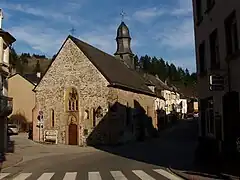 Church of St Nicholas.
Church of St Nicholas. Bust of Victor Hugo.
Bust of Victor Hugo.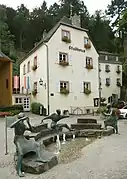 Town hall.
Town hall.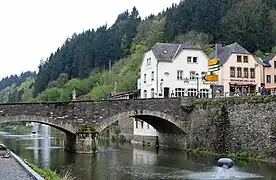 Bridge over the Our river, Vianden.
Bridge over the Our river, Vianden.
References
- "Surface area of the cantons and municipalities". Statistics Portal - Grand Duchy of Luxembourg. Retrieved 27 May 2016.
- "Population by canton and municipality 1821 - 2017". Statistics Portal - Grand Duchy of Luxembourg. Retrieved 30 December 2017.
- "Présentation" (in French). Vianden - La commune. Retrieved 29 May 2016.
- "Altitudes of the different localities per cantons (in m)". Statistics Portal - Grand Duchy of Luxembourg. Retrieved 10 June 2016.
Other websites
- Official website (in French)
- Vianden Castle